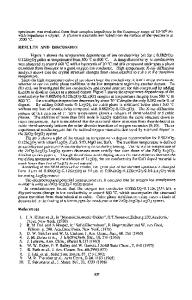Phase Relationships and Phase Formation in the System BaF 2 -BaO-Y 2 O 3 -CuO x -H 2 O
- PDF / 373,511 Bytes
- 12 Pages / 612 x 792 pts (letter) Page_size
- 45 Downloads / 341 Views
Phase Relationships and Phase Formation in the System BaF2-BaO-Y2O3-CuOx-H2O W. Wong-Ng ,L.P. Cook, J. Suh, I. Levin, M. Vaudin, R. Feenstra1, and J.P. Cline Ceramics Division, National Institute of Standards and Technology Gaithersburg, MD 20899, U.S.A 1 Solid State Division, Oak Ridge National Laboratory Oak Ridge, TN 37831, U.S.A.
ABSTRACT The interplay of melting equilibria and reaction kinetics is important during formation of the Ba2YCu3O6+x (Y-213) phase from starting materials in the quaternary reciprocal system Ba,Y,Cu//O,F. For experimental investigation of the process we used a combination of differential thermal analysis (DTA) for study of melting equilibria, and in-situ high-temperature x-ray diffraction (HTXRD) for study of the phase formation and reaction kinetics. DTA investigation of compositions spaced along compositional vectors extending from the oxide end to the fluoride end of the reciprocal system have given evidence of low melting liquids (~600 °C) near the fluorine-rich end. Work is continuing to determine whether similar thermal events observed in the interior of the system also indicate low temperature liquids, and on the extent to which low-melting liquids could be involved in Y-213 phase formation. HTXRD investigations have been initiated on the conversion of 0.3 µm and 1.0 µm thick BaF2-Y-Cu precursor films to Y-213 in the presence of water vapor. Preliminary results indicated that the thickness of film has a strong influence on the texture of the Y-213 film: a 0.3 µm film showed mainly (001) texture, whereas a 1.0 µm film showed a greater volume fraction of (h00) texture. While the HTXRD method cannot directly reveal the presence of liquid, we are working to combine DTA and HTXRD data for a unified picture of Y-213 phase formation during the “BaF2 ex-situ” process for coated-conductor fabrication.
INTRODUCTION The “BaF2 ex situ process”, in which e-beam co-evaporated BaF2-Y-Cu-precursor films are deposited on substrates, followed by post-annealing in the presence of H2O vapor, has the potential for producing high-quality, long-length, high-Jc, high Tc Ba2YCu3O6+x (Y-213) superconductors [1]. The BaF2 process dates back to 1987, when Mankiewich et al. [2] reported the use of BaF2 to prepare evaporated precursor films. In the following year, a trifluoroacetate (TFA) method for preparing the precursor was demonstrated by Gupta et al. [3]. In the same year, Chan et al. [4] described a reaction model using H2O to decompose the BaF2. They also emphasized the importance of removing the product HF for speeding up the reaction. In 1990, McIntyre et al. [5] successfully produced high-Jc, c-axis aligned YBCO coatings by the TFA method. Some beneficial effects of processing under reduced oxygen pressure were also noted [6,7]. They further developed this process during the 90’s. In 1991, Feenstra et al. [1] reported on the phase stability of Y-213 at reduced oxygen partial pressure down to 10-4 atm. Use of E9.7.1
reduced pO2 allowed lowering of the processing temperature to 700 ºC -750 ºC. By 1
Data Loading...











